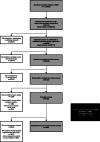Effects of the Active Kids voucher program on children and adolescents' physical activity: a natural experiment evaluating a state-wide intervention
- PMID: 33423663
- PMCID: PMC7798231
- DOI: 10.1186/s12889-020-10060-5
Effects of the Active Kids voucher program on children and adolescents' physical activity: a natural experiment evaluating a state-wide intervention
Abstract
Background: There is an urgent need for scaled-up effective interventions which overcome barriers to health-enhancing physical activity for children and adolescents. In New South Wales (NSW), Australia, the state government implemented a universal voucher program, 'Active Kids' to support the cost of structured physical activity registration for school-enrolled children aged 4.5-18 years old. The objective of this study was to understand the effects a financial incentive intervention delivered in a real-world setting has on children and adolescent's physical activity participation.
Method: In 2018, all children and adolescents registered for an Active Kids voucher provided sociodemographic characteristics, physical activity and research consent. This prospective cohort study used an online survey with validated items to measure physical activity and other personal and social factors in children and adolescents who used an Active Kids voucher. Generalized linear mixed models were used to examine changes from registration to after voucher use at ≤8 weeks, 9-26 weeks and ≥ 6 months.
Results: Study participants reported increasing their days achieving physical activity guidelines from 4.0 days per week (95%CI 3.8, 4.2) at registration (n = 37,626 children) to 4.9 days per week (95%CI 4.7, 5.1) after 6 months (n = 14,118 children). Increased physical activity was observed for all sociodemographic population groups. The voucher-specific activity contributed 42.4% (95%CI 39.3, 45.5) to the total time children participated in structured physical activities outside of school. Children and adolescents who increased to, or maintained, high levels of activity were socially supported to be active, had active parent/caregivers, had better concentration and were overall happier than their low-active counterparts.
Conclusion: The Active Kids program significantly increased children's physical activity levels and these increases continued over a six-month period. The Active Kids voucher program shows promise as a scaled-up intervention to increase children and adolescents' physical activity participation.
Trial registration: Australian New Zealand Clinical Trial Registry ACTRN12618000897268 , approved May 29th, 2018 - Retrospectively registered.
Keywords: Adolescents; Behavior change; Children; Evaluation; Financial incentive; Leisure-time; Organized sport; Physical activity; Policy; Voucher.
Conflict of interest statement
The authors declare that they have no competing interests.
Figures
Similar articles
-
Population level effects of the active kids program on children and adolescents' physical activity and sport participation in NSW, Australia.Int J Behav Nutr Phys Act. 2025 May 28;22(1):65. doi: 10.1186/s12966-025-01763-2. Int J Behav Nutr Phys Act. 2025. PMID: 40437604 Free PMC article.
-
Physical Activity Behaviors of Children Who Register for the Universal, State-Wide Active Kids Voucher: Who Did the Voucher Program Reach?Int J Environ Res Public Health. 2020 Aug 6;17(16):5691. doi: 10.3390/ijerph17165691. Int J Environ Res Public Health. 2020. PMID: 32781753 Free PMC article.
-
Active Kids: evaluation protocol for a universal voucher program to increase children's participation in organised physical activity and sport.Public Health Res Pract. 2021 Jun 9;31(2):30122006. doi: 10.17061/phrp30122006. Public Health Res Pract. 2021. PMID: 34104931
-
Parents' Perceptions of Children's and Adolescents' Use of Electronic Devices to Promote Physical Activity: Systematic Review of Qualitative Evidence.JMIR Mhealth Uhealth. 2023 Jul 20;11:e44753. doi: 10.2196/44753. JMIR Mhealth Uhealth. 2023. PMID: 37471127 Free PMC article.
-
A comparative study of the physical activity guidelines for children and adolescents from five countries and WHO.Front Public Health. 2024 Jul 12;12:1421843. doi: 10.3389/fpubh.2024.1421843. eCollection 2024. Front Public Health. 2024. PMID: 39071153 Free PMC article. Review.
Cited by
-
Physical activity-the past, present and potential future: a state-of-the-art review.Health Promot Int. 2025 Jan 17;40(1):daae175. doi: 10.1093/heapro/daae175. Health Promot Int. 2025. PMID: 39835580 Free PMC article. Review.
-
Population level effects of the active kids program on children and adolescents' physical activity and sport participation in NSW, Australia.Int J Behav Nutr Phys Act. 2025 May 28;22(1):65. doi: 10.1186/s12966-025-01763-2. Int J Behav Nutr Phys Act. 2025. PMID: 40437604 Free PMC article.
-
Insights from a codesigned dynamic modelling study of child and adolescent obesity in Australia.BMJ Public Health. 2025 Jan 11;3(1):e001164. doi: 10.1136/bmjph-2024-001164. eCollection 2025. BMJ Public Health. 2025. PMID: 40017932 Free PMC article.
-
Impact and recovery of the COVID-19 pandemic on weight status of children and adolescents.Clin Obes. 2023 Apr;13(2):e12579. doi: 10.1111/cob.12579. Epub 2023 Jan 22. Clin Obes. 2023. PMID: 36682362 Free PMC article.
-
Higher Family Affluence is Associated With Multi-Sport Participation Among Irish Youth.Percept Mot Skills. 2023 Oct;130(5):1869-1888. doi: 10.1177/00315125231185653. Epub 2023 Jun 27. Percept Mot Skills. 2023. PMID: 37366222 Free PMC article.
References
-
- World Health Organization . Global action plan on physical activity 2018–2030: more active people for a healthier world. Geneva: World Health Organization; 2018.
-
- World Health Organization . Global recommendations on physical activity for health. Geneva, Switzerland: World Health Organization; 2010. - PubMed
-
- Australian Government Department of Health. Australian 24-Hour Movement Guidelines for Children and Young People (5 to 17 years): An Integration of Physical Activity, Sedentary Behaviour, and Sleep. Australian Government; 2019.
Publication types
MeSH terms
Associated data
LinkOut - more resources
Full Text Sources
Other Literature Sources
Medical




